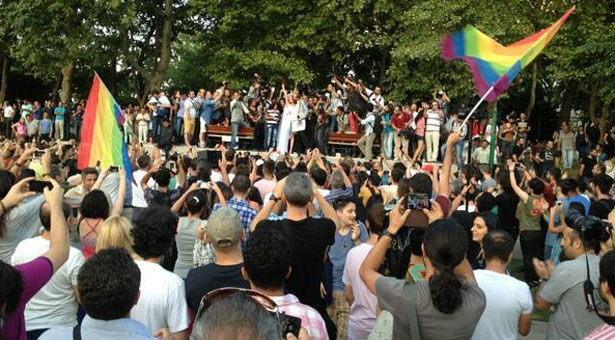There has been an Arab Spring, then a Spanish Spring, an “Occupy” Spring in the US, a Greek Spring and now a Turkish Spring. All these movements, protests and riots are the expression of popular indignation, indignation against authoritarian and repressive powers, brutal neoliberal policies, destructive ecocide, This is very important, because without indignation nothing significant ever happened in history.

Sendika.Org: Your name was written on the declaration asking to end the state terror encountered in the previous days in Turkey. Public riot against the brutal state terror is being interpreted as “Turkish Spring’’, specially by some European newspapers. Do you approve to liken the process experienced in the Middle East and called ‘’Arab Spring’’ with the events happening in Turkey?
M.Löwy: There has been an Arab Spring, then a Spanish Spring, an “Occupy” Spring in the US, a Greek Spring and now a Turkish Spring. All these movements, protests and riots are the expression of popular indignation, indignation against authoritarian and repressive powers, brutal neoliberal policies, destructive ecocide, This is very important, because without indignation nothing significant ever happened in history.
Which aspects are similar and which are different?
Between the Arab and the Turkish Spring there are many similarities: these are large mass movements of protest against authoritarian regimes with iniquitous neoliberal policies, in which the youth is the most active, radical and combative element. Of course there are differences : in the Arab countries these were archaic and corrupted dictatorships, while in Turkey there is a sort of “democracy of low intensity”, and the authoritarian, brutally repressive Erdogan government still has a (conservative) popular base. This is why the Arab Spring was able to bring down the Ben Alis and the Moubaraks, while this seems much more difficult in Turkey.
In this framework how do you evaluate the developments in Turkey?
The mass upsurge which began in Istanbul but spread throughout the country, the awakening of popular protest, the massive participation of youth and women in the movement are some of the aspects of the Turkish Spring that make it an historical turning point in recent Turkish history. Whatever the immediate results of the movement, there will be a before and after the Turkish Spring.
As you know, insurgence in Turkey broke out when the police brutally attacked a group of people who were trying to prevent the trees in Gezi Park (in Taksim Square) from being cut and prevent the park from being transformed to a shopping mall and artillary barracks. Can this event that caused a breakout of insurgence be evaluated as an indication of the fact that the struggle for nature is never independent from struggle against capitalism? In other words, how can this insurgence be evaluated in the framework of a new revolutionary socialist perspective?
I think that it is very important that the movement in Turkey began with a struggle to save the trees of Gezi Park. This illustrates the explosive potential of ecological issues, once they are linked to other key issues such as capitalist exploitation, anti-popular neo-liberal policies, brutal State repression, oppression of the Kurdish people, etc. It is too soon to tell if this formidable insurgency in Turkey will become the framework of a revolutionary socialist perspective. But it shows the importance of linking socialism with ecology, in an ecosocialist revolutionary program.
Insurgence in Turkey, rather than having a Subject concretely defined, is generally evaluated as “people’s uprising” and we can say it has a strong “middle class” character. However, same “middle class” is now subjected to many analysis evaluating these events in the context of “new proletariat” , “proletarianization of the petit bourgeoisie” and so on. When considered the uprisings in Middle East, in Washington, in Brasil, in Turkey how do you evaluate the “subjects” of these insurgences?
Following the socio-economic analysis of Ernest Mandel, I’m sceptical of the term “middle-class”. The social groups which have been mobilized in these uprisings – students, technicians, service employees, etc – belong to the labour class, to the proletariat in the broad and only effective meaning : people who live by selling their labour force for a wage. The vast majority of the people in all modern societies belong to the labour class; as the Occupy movement in the US emphasized, it is the 99% against the 1% of the ruling class, capitalists, bankers, and their servants. Of course, the subject of these movements is plural, diverse, with different motivations. The main component is youth, but there are also national minorities, women, trade-unionists, ecologists, both secular and religious people, and of course a great diversity of leftist organizations. The important thing is the common indignation against the system and the government it represents.
There’re two approaches in the evaluation of Marxist “primitive accumulation”: In the first one “primitive accumulation” is taken as a stock accumulation that had already realized before Capitalist system was founded. Second approach asserts that primitive accumulation is an intrinsic and sustainable element in capitalism. Do you think that the insurgences in Turkey and other countries support the second understanding?
Yes, I believe that primitive accumulation has become a permanent and intrinsic dimension of capitalism, particularly in the peripheric countries. Of course, this accumulation takes new forms in the 21th century, different from those of the 17th, analysed by Marx in Capital vol. 1. But there are many similar features : the commons are being privatized, people expelled from the land, and state violence is used in grand scale to assure the accumulation of capital. The exploitation of labour takes in many countries of Asia and Africa semi-servile forms, and the foreign debt is used as a powerful instrument of accumulation. The answer to permanent accumulation is permanent revolution!
Interview: Özay Göztepe